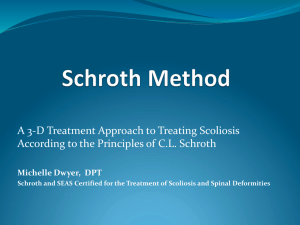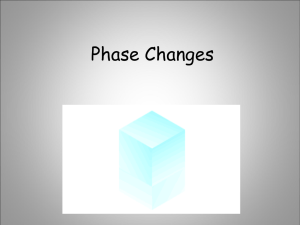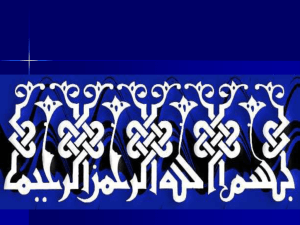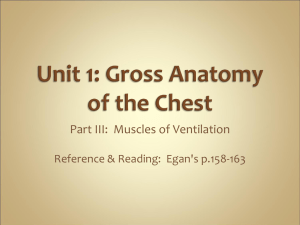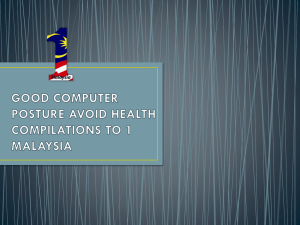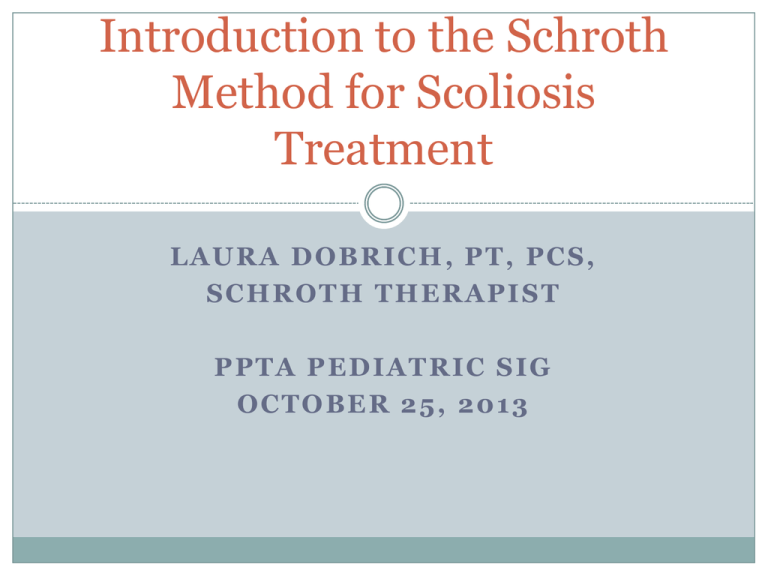
Introduction to the Schroth
Method for Scoliosis
Treatment
LAURA DOBRICH, PT, PCS,
SCHROTH THERAPIST
PPTA PEDIATRIC SIG
OCTOBER 25, 2013
United States
Surgery
Bracing
Observation
Europe
Surgery
Bracing
Physical Exercises
Possible explanations for treatment differences
Literature published in languages other than English
not cited by US researchers
Research typically with pts with mild AIS (< 30⁰) –
which is generally not treated in US
Lack of support/interest promoting research in this
area in US
All conservative methods often considered together
as “alternative treatment”
History of the Schroth Method
First developed in 1921 in Germany
After WWII, East Germany ordered a 3-year
investigation of the method
Resulted in the Schroth House being “nationalized”
to allow access to more people
In 1955, moved to West Germany
In 1961, Schroth Klinic opened in Bad Sobernheim.
Schroth Objectives
Improvement of posture and appearance
Improvement of static/dynamic postural control and
stability (achieve/maintain “conscious posture” in
ADLs)
Deceleration or prevention of curve progression
Avoidance of braces or surgery
Support for decision-making process @ curve
threshold
Reduction of pain
Improvement of vital capacity
Team Members
Physician
Physical Therapist
Orthotist
Surgeon
Psychologist
Patient
Parents
Schroth Elements
Guiding resistance
Facilitation
Proprioceptive and visual stimuli
Passive corrective forces
Treatment Components
Positioning
Specific mobilization
Self-correction
Breathing Correction
Active mobilization
Stabilization (exercises)
Schroth in ADL
Review of the Literature
2005:
SOSORT (International Society on Scoliosis
Orthopaedic and Rehabilitation Treatment)
Established to verify the scientific basis and efficacy of
exercises & bracing
Scoliosis
New journal launched to promote new research on this
topic
SOSORT 2005
Consensus agreement for standard features in rehab
for scoliosis:
1. 3-D Autocorrection exercises
2. ADL training
3. Stabilization of the correct posture
4. Patient education
5. Multidisciplinary team – MD, PT, Orthotist
Autocorrection
3-D active correction of curve
SEAS
(Scientific Exercises Approach
to Scoliosis)
Schroth Method
Dobomed Program
Other programs approved – see
SOSORT 2011 Recommendations
SOSORT 2011
Recommendations for Exercises
SEE HANDOUT
Scoliosis Journal 2010
“Rehabilitation Schools for Scoliosis” series
To investigate efficacy of exercise on scoliosis with
clearly defined guidelines for research
Studies to include specifics of treatment including
description and pictures of exercises
Studies should follow SOSORT recommendations
Weiss (2010) - Scoliosis
Review of conservative approaches:
Outcome of brace treatment determined primarily by in-brace
correction and patient compliance
Some evidence that correct bracing can stop curve progression
OP treatment sufficient for patients with spinal deformity
without other limitations
IP rehab recommended for patients with pain or restrictive
ventilatory disorder
Fusco et al (2011)
Updated systematic review
• Detailed Appendix describing several exercise methods with
pictures
20 studies showing:
Efficacy of exercise in reducing rate of progression &/or
improving Cobb angle
Exercise effective in reducing brace prescription
Exercise improves strength, mobility, and balance
Fusco et al (cont)
Physical exercises, if administered correctly, can
prevent curve progression and prevent need for
bracing
PTs need to use specific exercises chosen according
to strong scientific sources
Literature using unsound methodology and
interventions can suggest that physical exercises
are not effective, while scientifically-based physical
exercises appear to be efficacious
PE Efficacy Summary
Need for further studies, esp RCTs, following
SOSORT criteria, to improve level of evidence
Present evidence is sufficient to consider PEs as an
appropriate intervention for AIS
3-D Autocorrection exercises appear to be best, but
cannot yet support a specific program
Not yet clear if inpatient vs outpatient or intrinsic vs
extrinsic exercises most effective
Recently Published Research
Physical exercises in the treatment of adolescent idiopathic
scoliosis: an updated systematic review – Physiotherapy
Theory and Practice (2011) - PEs can improve the Cobb
angles of individuals with AIS and can improve strength,
mobility, and balance.
Scoliosis short-term rehabilitation (SSTR) according to
'Best Practice' standards-are the results repeatable?
Scoliosis (2012) – angle of trunk rotation and VC improved
and repeatable
Weiss HR, Cherdron J (1994)
Effects of Schroth's rehabilitation program on
the self concept of scoliosis patients
37 scoliotic patients (33 female, 4 male), aged 20-57
years
pre-/post-interview study on the basis of the Frankfurt
self-concept scales (FSKN)
statistically significant changes in a positive direction
found for 7 of 10 self-concept scales
general coping ability; sensitivity and mood; selfassertion towards groups and significant others;
perceived appreciation by others; feelings towards and
relationship with others; self-worth; and ability to make
contact and interact.
Weiss et al (2003)
Incidence of Curvature Progression in Idiopathic
Scoliosis Patients Treated with Scoliosis In-patient
Rehabilitation (SIR): an age- and sex-matched
controlled study
Two independent patient groups matched by age and
sex at diagnosis
One group was untreated and the other received
scoliosis in-patient rehabilitation (SIR) (Schroth)
Incidence of progression in groups of untreated
patients ranged from 1.5-fold to 2.9-fold higher than in
groups of patients treated with SIR, even when SIRtreated groups included patients with more severe
curvatures.
Otman et al (2005)
The Efficacy of Schroth’s 3-dimensional Exercise
Therapy in the Treatment of Adolescent Idiopathic
Scoliosis in Turkey
50 patients, 1999- 2004, average age 14.15±1.69 years
Outpatient 5 days/wk, 4 hr/day x 6 wk then home
program
Evaluated Cobb angle, vital capacity and muscle strength
of the patients before treatment, and after 6 weeks, 6
months and one year
Schroth technique positively influenced the Cobb angle,
vital capacity, strength and postural defects
Otman et al (2005)
Cobb angle 26.1⁰ average before treatment, 23.45⁰
after 6 weeks, 19.25⁰ after 6 months and 17.85⁰ after
one year (p<0.01)
VC average 2795 ml before treatment, reached 2956
ml after 6 weeks, 3125 ml after 6 months and 3215
ml after one year (p<0.01)
Jelacic et al (2011)
Barcelona Scoliosis Physical Therapy School–
BSPTS–based on classical Schroth principles: shortterm effects on back asymmetry in idiopathic
scoliosis
Retrospective, 47 pts treated exclusively with exercises.
Mean age 18.64 ± 5.78 years.
Surface topography (Formetric) was performed to
measure trunk imbalance, surface rotation and lateral
deviation before and after the treatment period.
Improvements noted in mean trunk imbalance, lateral
deviation mean and max, and surface rotation.
Schreiber et al (2013)
The effects of a 6-month Schroth intervention for
Adolescent Idiopathic Scoliosis (AIS): preliminary
analysis of an ongoing randomized controlled trial
31 patients with AIS, aged 10-18, with curves from 10°45°, wearing a brace or not. 16 randomized to Schroth
with standard care, and 15 to standard care alone
(monitoring or bracing) for six months.
Schroth exercises showed a small but positive influence
on self-efficacy, self-image, pain and back muscle
endurance.
Schroth Terms
Rib Hump – thoracic convexity. Most rotated, most
prominent, and most posterior aspect at the apex.
Ribs are rotated posteriorly and spread apart
resembling the “inhalation position”
Weak Side – ribs of the thoracic concavity are closer
and lower, resembling the “exhalation position”.
Ribs are rotated forward. Area appears flat and
hollowed.
Schroth Terms
Lumbar Prominence – Lumbar convexity. Extensor
muscles become overstretched and are displaced
posteriorly. Leads to asymmetric waistline, full on
convex side and accentuated on concave side.
Weak Point – Lumbar concavity. TPs rotated
anteriorly and muscles/connective tissues shortened.
Waist is accentuated and pelvis appears shifted to
this side.
Schroth Terms
Protracted Shoulder – Shoulder on thoracic convex
side is IR with inferior angle of scapula moved
upward and tilted away from the ribcage.
Retracted shoulder – Shoulder on thoracic concave
side is ER and may sink into the thoracic cavity
(scapula appears to wing, but this is really secondary
to lack of rib support).
May vary if a high thoracic or cervical compensatory
curve is present
Schroth Terms
Ventral Flat Zone – Ventral aspect of the rib hump.
Ribcage appears compressed; apical ribs closer and
rotated posteriorly. Breast looks smaller.
Ventral Prominence – Lower ribs of thoracic concave
side are ventrally more prominent due to spinal rotation.
Creates a “ventral rib hump”
Prominent Hip – Pelvis deviated laterally as
compensation for either T or L curve; causes hip
adduction and raised iliac crest on that side. Increased
WB on side opposite of prominent hip. (Prominent hip
usually opposite side of primary curve).
Schroth Evaluation
Medical History
• Age/gender/age at first menses
• X-rays?
• Cobb Angle
• Brace? Type/schedule/compliance
• Previous treatment?
Risser Sign
*Radiographic measurement of skeletal maturity
based on ossification of the iliac apophysis
*Ossification begins laterally; progresses
medially
*Proceeds from 0 (no ossification) to 5 (ossified
apophysis fused completely to ilium
Progression Factor
Cobb angle – (3 x Risser sign)
Chronological Age
Schroth
Evaluation
Body Blocks
Pelvic block (includes LEs)
Iliac crest height/rotation
pelvic shift/tilt/rotation,
PSIS/ASIS height/rotation
Lateral shift
LE positioning, abd/add, hip rotation, knee
position (recurvatum, patellar position, patellar
height) foot arches/pronation/supination
Shoe lift/LLD?
Weight bearing symmetry
Lumbar Block
Waist lines
Lumbar prominence
Lordosis
Thoracic Block
Scapular position (height, orientation,
symmetry)
Angle of inferior border
Rib hump
Space between arm and body
Rib position (widened, narrowed, elevated)
Breast height/size
Shoulder Block
Level of shoulders
Protraction/retraction
Head position
Upper thoracic/cervical curve
Schroth Evaluation
Forward Bend Test
Flexibility – side shift, side
bend, finger-to-floor
measurement (lateral flexion),
active rotation
Schroth Classification
Named by position of thoracic convexity
(right/left)
Static standing posture determines primary
curve (increased WB on side of primary
curve)
3c = primary thoracic curve
4c = primary lumbar curve
p = pelvic involvement (lateral shift,
elevation away from primary convexity)
3 c right
3 cp Right
4c Right
4 cp Right
Schroth Postures
Habitual Posture
Resting Posture
Conscious Posture
Correct Posture
Schroth Postural Terms
Habitual Posture – Resting scoliotic position
Relaxed Posture – Gravity-eliminated, lying. Side lying
on the concave side of the main curve is preferred.
For primary thoracic curves, on the thoracic concave side
with knees flexed
For primary lumbar curves with small or no thoracic curve,
on the lumbar concave side
For double major curves, on thoracic concave side with
lower leg flexed and upper leg extended to stretch the
lumbar concavity
Schroth Postural Terms
Conscious Posture - Postural correction as close to
physiologically-typical posture as possible without
requiring great physical or cognitive effort.
Goal is to transfer this posture from exercise to
dynamic alignment for daily life
Symmetrical WB in sitting and standing (can depress
the elevated side or raise the opposite side in sitting),
correction of pelvic shift, shift of ribcage toward
thoracic concave side
Schroth Postural Terms
“Correct Posture” – Exercise position that
approaches the flexibility threshold of the curve;
attempts to reverse the curve.
Requires concentration and coordination, correct
breathing, and specific muscle tension and
lengthening
Visual feedback provided with mirrors in front and
back
Therapist provides specific resistances and
facilitation/elongation, instructions, and feedback.
Schroth Treatment
MANUAL
TECHNIQUES
Side bending in sitting
Side Bending
Used to test flexibility of curve
and for mobilization
Pt sitting on table, arms
crossed, bring to neutral,
upright spine as able
Test thoracic and lumbar
curves bilaterally
Mobilize by placing one hand
on apex, other on opposite
shoulder
Ventral, medial, cranial
mobilization to passively
correct rib hump
Side shift in sitting
Side Shift
Pt sitting in chair with UEs
supported on table
PT standing on thoracic
concave side
One hand reaches across front
of pt and grasps rib hump;
other hand at transitional
vertebra (do not allow
movement past this point)
Translation of rib hump
toward concave side (medial
translation with some
anterior derotation)
Derotation of the rib hump in sitting and supine
Derotation of Rib Hump
In sitting, passively retract shoulder. Mobilize rib
hump ventral, medial, cranial.
Pt can do this actively by bringing shoulder back,
down, and externally rotating
In supine, ER protracted shoulder, place support
under retracted shoulder. Stabilize pelvis in
posterior direction while mobilizing rib hump
forward and medial
Pt can hold corrected position
Derotation of the Ventral Prominence in Sitting and Supine
Derotation of ventral prominence
Pt sitting on chair with UEs supported on table
Bring retracted shoulder forward
Mobilize ventral prominence (thoracic concave side)
posterior, lateral, cranial
In supine, ER protracted shoulder
Therapist stands on opposite side. “Iron”
prominence laterally and dorsally
Can use other hand to bring lumbar prominence
forward
Derotation of the lumbar prominence
Derotation of the lumbar prominence
In sitting, stabilize rib hump in anterior/medial
direction
Mobilize lumbar prominence anteriorly and medially
In prone, place thumb over apical transverse process
(most rotated/prominent TP)
Place other hand on top of thumb and derotate
anteriorly and medially
Can also specifically mobilize segments to increase
extension, rotation as needed
Stretching of thoracic concavity
Stretching of thoracic concavity
Lie on thoracic convex side with
support under rib hump
Do not lie on convexity if curve is
severe or non-flexible
Stretch soft tissue at least 20 sec
Can also provide massage,
ribcage mobilization, fascial
techniques
Pt can actively pull top arm up on
inhalation while therapist fixes
rib downward with exhalation
and holds; move segmentally up
rib cage
Stretching of lumbar concavity
Stretching of lumbar concavity
Side lying on lumbar
convexity over support
Passive mobilization
and stretching of
concavity
PNF Posterior
Depression
Side lying on
thoracic concavity
with support under
lumbar convexity
Provide
forward/diagonal
resistance to upper
ischial tuberosity
Pt actively pushes
into the resistance
in posterior
depression
Facilitated Breathing
•
•
•
•
•
HAND PLACEMENT ON CONCAVITIES
(WEAK SIDE, WEAK POINT, VENTRAL
FLAT ZONE)
CAN WORK IN ONE AREA AT A TIME OR 2
SIMULTANEOUSLY IF PATIENT IS ABLE
PALPATE BREATHING AND SYNC YOUR
BREATHING WITH PATIENT
BEGIN TO PROVIDE RESISTANCE DURING
INSPIRATION IN MEDIAL, FORWARD
DIRECTION
ASK PATIENT TO BREATHE “OUT, BACK,
AND UP” INTO YOUR HANDS
Positioning Supports (towel roll,
rice bag). Positions maintained 10-15 min
SUPINE
• UNDER RETRACTED SHOULDER
• UNDER RIB HUMP
• UNDER LUMBAR PROMINENCE
• UNDER PELVIS TO DEROTATE IN A
PRIMARY THORACIC CURVE WITH
PELVIC INVOLVEMENT (NOT IN
PRIMARY LUMBAR CURVE; CAN
WORSEN LUMBAR ROTATION)
Positioning Supports
PRONE
• UNDER FOREHEAD
• UNDER PROTRACTED SHOULDER
• UNDER VENTRAL PROMINENCE
• UNDER PELVIS TO DEROTATE IN A
PRIMARY THORACIC CURVE WITH
PELVIC INVOLVEMENT (NOT IN
PRIMARY LUMBAR CURVE; CAN
WORSEN LUMBAR ROTATION)
Positioning Supports
SIDE LYING
LIE ON SIDE OF THORACIC CONCAVITY
• ROLL SUPPORT UNDER LUMBAR
CONVEXITY
• BOTTOM ARM ABOVE HEAD; HEAD
RESTS ON ARM
• ACTIVE EXERCISE – DEPRESS UPPER
LEG CAUDALLY, LIFT OFF SURFACE
•
Positioning Corrections
UE POSITIONING FOR SYMMETRICAL
THORACIC SPINE:
90 DEGREE ABDUCTION WITH ELBOWS
FLEXED AT 90 DEGREES.
ISOMETRIC CONTRACTION OF SCAPULAR
ADDUCTOR AND SERRATUS ANTERIOR
CORRECTS SAGITTAL PLANE DEFORMITY
(SHOULDERS POSITIONED BACK FOR
KYPHOSIS REDUCTION, SHOULDERS
POSITIONED FORWARD FOR FLAT BACK
CORRECTION)
Positioning Corrections
POSITIONING FOR THORACIC CURVE:
UE ON THORACIC CONVEX SIDE AT 90
DEGREE ABDUCTION/90 DEGREE ELBOW
FLEXION.
PATIENT CAN ACTIVELY ER AND ADDUCT
SCAPULA TO SELF-MOBILIZE RIB HUMP
UE ON THORACIC CONCAVE SIDE
POSITIONED DIAGONALLY TO STRETCH
THE CONCAVITY
Positioning Corrections
POSITIONING FOR LUMBAR CURVE:
ACTIVE DEPRESSION OF PELVIS IN
CAUDAL DIRECTION ON LUMBAR
CONCAVE SIDE TO STRETCH LUMBAR
CONCAVITY
PELVIC SHIFT AWAY FROM THE
PROMINENT HIP IN CURVES WITH
PELVIC INVOLVEMENT. BODY WEIGHT
SHOULD BE TRANSFERRED TO SIDE OF
PROMINENT HIP.
Conscious Posture
Goal is to teach the conscious posture so that it can
be maintained without supports throughout the day
Can use breathing corrections as self-facilitation of
conscious posture
Pelvic symmetry, equalize WB, bring convexities
medial and anterior
Change postural habits – overhead reach with UE of
thoracic concave side, WB on UE of thoracic concave
side in sitting for elongation
Positioning for elongation
Right thoracic, Left lumbar curves
Incorrect
Correct
Pelvic Corrections
1.
2.
3.
4.
5.
Feet parallel. Knees unlocked. Pelvis balanced over
center of feet.
Adjust anterior/posterior tilt to physiological position
(about 30 degrees).
Lateral shift of pelvis to correct prominent hip
(Increase WB away from primary curve, shift pelvis
toward primary curve).
Derotate the pelvic block (but do not correct a primary
lumbar curve with pelvic involvement – can increase
the lumbar rotation)
Depress elevated hip. In sitting, can elevate the
opposite side with passive support.
Exercise Sequencing
1.
2.
3.
4.
5.
6.
Positioning
Elongation of spine with normal breathing
Corrective breathing. Use isometric tension to hold
corrected posture on exhalation as able.
Dynamic exercise performed during exhalation for
predetermined # of reps.
Rest between sets maintaining conscious posture.
ie 4 sets of 6 reps (each repetition = 1 breathing
cycle)
Standing with Poles
Side Hanging from ladder rungs
Pelvic Tilt (depression)
Schroth Training Options
Barcelona School (Dr. Manuel Rigo)
Spain, Israel, or Wisconsin – 10-day course for part 1
certification AND 6-day course 1-3 years later for Part 2
certification
Schroth (Asklepios) courses
Bad Sobernheim, Germany – 10-day certification, recommend
3-yr refresher (English courses available)
New York, NY – 3 3-day course and testing for certification –
Courses also offered in Latvia, Estonia, Hungary, S. Korea, Thailand
Finding a Schroth-trained therapist
http://www.hunter.cuny.edu/pt/the-schroth-
method-of-management-of-scoliosis
http://www.bspts.net/bsptspts.html
Thank You!!

